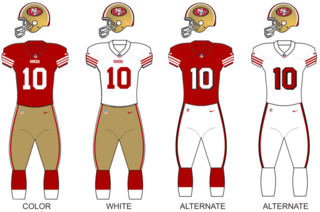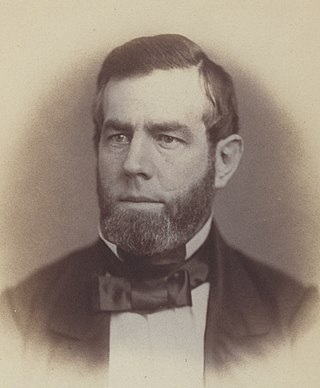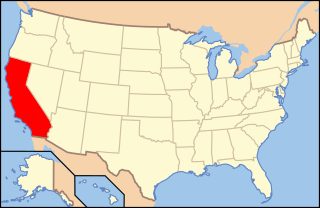San Francisco Gold Rush may refer to:
- San Francisco 49ers Gold Rush, a cheerleading squad
- California gold rush, 1848–1855
San Francisco Gold Rush may refer to:

The San Francisco 49ers is a professional American football team based in the San Francisco Bay Area. The 49ers compete in the National Football League (NFL) as a member of the league's National Football Conference (NFC) West division, and play their home games at Levi's Stadium in Santa Clara, California, located 38 miles (61 km) southeast of San Francisco. The team is named after the prospectors who arrived in Northern California in the 1849 Gold Rush.

The California gold rush (1848–1855) was a gold rush that began on January 24, 1848, when gold was found by James W. Marshall at Sutter's Mill in Coloma, California. The news of gold brought approximately 300,000 people to California from the rest of the United States and abroad. The sudden influx of gold into the money supply reinvigorated the American economy; the sudden population increase allowed California to go rapidly to statehood in the Compromise of 1850. The Gold Rush had severe effects on Native Californians and accelerated the Native American population's decline from disease, starvation, and the California genocide.

Northern California is a geographic and cultural region that generally comprises the northern portion of the U.S. state of California. Spanning the state's northernmost 48 counties, its main population centers include the San Francisco Bay Area, the Greater Sacramento area, the Redding, California, area south of the Cascade Range, and the Metropolitan Fresno area. Northern California also contains redwood forests, along with most of the Sierra Nevada, including Yosemite Valley and part of Lake Tahoe, Mount Shasta, and most of the Central Valley, one of the world's most productive agricultural regions.
Niantic may refer to:

David Colbreth Broderick was an attorney and politician, elected by the legislature as Democratic U.S. Senator from California. Born in Washington, DC, to Irish immigrant parents, he lived in New York until moving to California during the Gold Rush. He was a first cousin of politicians Andrew Kennedy of Indiana and Case Broderick of Kansas. At age 39, Broderick was fatally wounded in a duel with a one-time friend.
49er or Forty-Niner most often refers to:
San Francisco Rush may refer to:

Sidney Patrick Grauman was an American showman who established two of Hollywood's most recognizable and visited landmarks, the Chinese Theatre and the Egyptian Theatre.
Boudin Bakery is a bakery based in San Francisco, California, known for its sourdough bread. The bakery is recognized as the "oldest continually operating business in San Francisco." It was established in 1849 by Isidore Boudin, son of a family of master bakers from Burgundy, France, by blending the sourdough prevalent among miners in the Gold Rush with French techniques.
Gold Mountain is a commonly used nickname for San Francisco, California, and historically used broadly by Chinese to refer to western regions of North America, including British Columbia, Canada. After gold was found in the Sierra Nevada in 1848, thousands of Chinese from Toisan in Guangdong, began to travel to the West in search of gold and riches during the California Gold Rush.

The Fraser Canyon Gold Rush, began in 1858 after gold was discovered on the Thompson River in British Columbia at its confluence with the Nicoamen River a few miles upstream from the Thompson's confluence with the Fraser River at present-day Lytton. The rush overtook the region around the discovery and was centered on the Fraser Canyon from around Hope and Yale to Pavilion and Fountain, just north of Lillooet.
A gold rush is a sharp migration of people to an area believed to have significant gold deposits.
The history of California can be divided into the Native American period, the European exploration period (1542–1769), the Spanish colonial period (1769–1821), the Mexican period (1821–1848), and United States statehood. California was one of the most culturally and linguistically diverse areas in pre-Columbian North America. After contact with Spanish explorers, many of the Native Americans died from foreign diseases. Finally, in the 19th century there was a genocide by United States government and private citizens, which is known as the California genocide.

The San Francisco 49ers Gold Rush Cheerleaders are the cheerleading team for the NFL's San Francisco 49ers. The current team was founded in 1983 by USA, which has been renamed to e2k. They have performed throughout the United States, Europe, and Japan. They are also involved in many charitable events.

Hangtown fry is a type of omelette made famous during the California Gold Rush in the 1850s. The most common version includes bacon and oysters combined with eggs, and fried together.
Lumley Franklin was the second mayor of Victoria, British Columbia. He was born in Liverpool, England, the son of a successful banker. Lumley emigrated from London to New York City in 1845 to establish his career in the U.S. He was a successful business man before he moved to San Francisco in 1854 to join his brothers Edward and Selim during the California Gold Rush. Lumley's cousins, Maurice and Lewis Franklin, had already left San Francisco to establish the Franklin House in San Diego, but frequently visited San Francisco.

The environment of California describes results of human habitation of the American State of California.

The Barbary Coast Trail is a marked trail that connects a series of historic sites and several local history museums in San Francisco, California. Approximately 180 bronze medallions and arrows embedded in the sidewalk mark the 3.8-mile (6.1 km) trail.

Yerba Buena Cove was a cove on San Francisco Bay where the Mexican pueblo of Yerba Buena was located. It lay between Clarks Point to the north and Rincon Point to the south. The beach of the cove was set back as far as what is now Montgomery Street between Clay and Washington Streets.